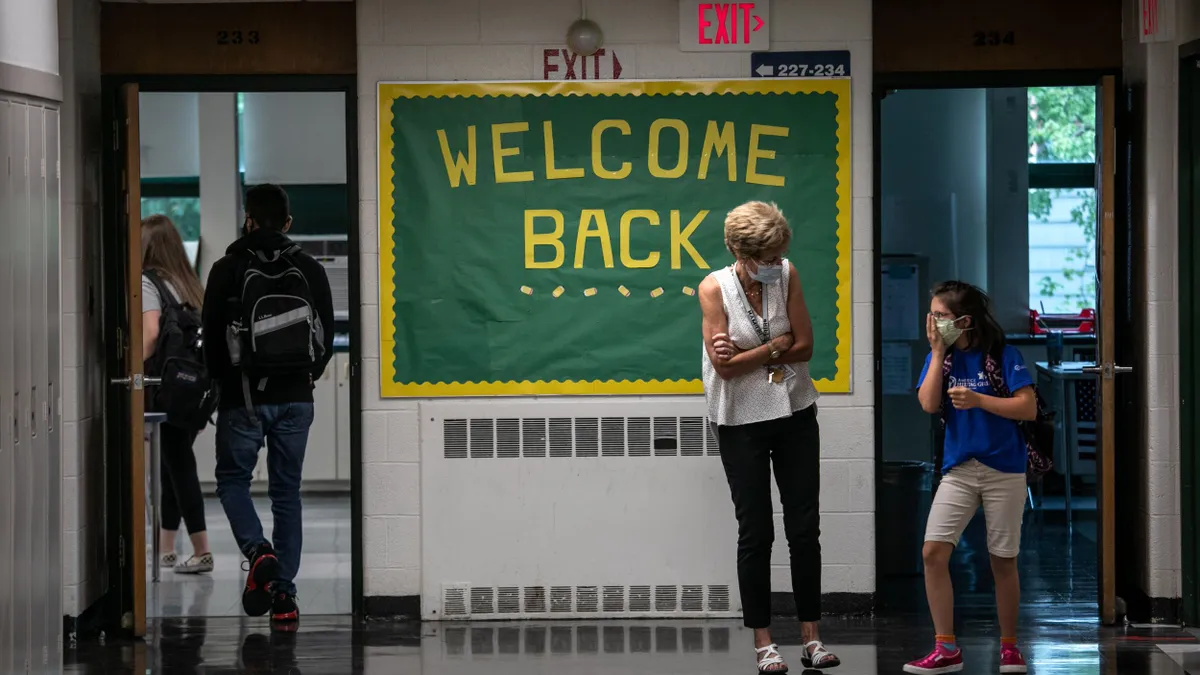Five years ago, the COVID-19 pandemic significantly disrupted school operations by halting in-person instruction in communities nationwide — in some cases for more than a year.
From vaccine rollouts to a surge in emergency federal funds to schools, these are the key moments that impacted education leaders since the pandemic emerged in 2020.
-
March 13, 2020President Donald Trump, in his first presidential administration, declared a national emergency for COVID-19, retroactive to March 1, 2020. Schools across the country start closing buildings and planning for virtual learning.
-
March 25, 2020Congress passes the Coronavirus Aid, Relief, and Economic Security Act, which includes the Elementary and Secondary School Emergency Relief fund (also known as ESSER). The $13.2 billion allocation helps schools provide devices and Wi-Fi access for virtual learning and to prepare for a safe return to in-person learning.
-
May 20, 2020The Centers for Disease Control and Prevention issues its first reopening guidance for schools, summer camps and colleges. This is followed on July 23, 2020, with further CDC guidance on how to reopen schools safely in the fall. The recommendations include how to keep school environments healthy through cleaning, proper ventilation, social distancing and other practices.
-
Dec. 11, 2020Pfizer-BioNTech receives emergency authorization from the U.S. Food and Drug Administration for COVID-19 vaccinations for people ages 16 and older. Schools begin discussing their roles in vaccination distribution and vaccine requirements for students and staff.
-
Dec. 27, 2020The Coronavirus Response and Relief Supplemental Appropriations Act is signed into law, giving schools $54.3 billion for continued efforts to provide in-person and virtual learning. These funds are also known as ESSER II.
-
January 2021Data collected by the federal government shows 38% of 4th graders nationwide are enrolled in full-time, in-person learning.
-
March 11, 2021The American Rescue Plan is signed into law. The legislation includes ESSER III, which at $121.9 billion is the largest one-time federal allocation ever given to U.S. schools. Together, the three ESSER allocations add up to $189.5 billion.
-
May 2021Slightly more than half (52%) of 4th graders across the country are enrolled in in-person, full-time learning.
-
Oct. 29, 2021The U.S. Food and Drug Administration authorizes the emergency use of the Pfizer-BioNTech COVID-19 vaccine to include children ages 5 to 11 years old.
-
December 2021Close to 100% of 7,400 schools surveyed between September and December 2021 report their 4th- and 8th-grade students are enrolled in full-time, in-person instruction, according to data from the National Center for Education Statistics.
-
Feb. 25, 2022The CDC announces updated COVID school guidance that only recommends mask requirements in communities with high levels of virus spread.
-
October 2022Reading and math data from the National Assessment of Educational Progress for 4th and 8th grades confirm the extent of pandemic learning loss, with results described at the time as ”appalling and unacceptable″ by then-U.S. Education Secretary Miguel Cardona.
-
Feb. 10, 2023The CDC’s Advisory Committee on Immunization Practices officially recommends that COVID-19 vaccines be included in routine vaccinations for children ages 18 and younger.
-
May 11, 2023The national emergency declaration for COVID comes to an end following a final extension by President Joe Biden in January 2023.
-
March 1, 2024The CDC updates COVID-19 guidance for community settings, saying that people who have tested positive can return to normal activities when they are fever-free for at least 24 hours without taking medication, rather than undergoing a 5-day isolation period. The guidance comes as schools deal with high rates of chronic absenteeism.
-
January 2025The Education Department releases 2024 NAEP reading and math assessment results for 4th and 8th graders that continue to disappoint educators, policymakers and the public. Student performance shows little to no progress toward returning to pre-pandemic levels in math and reading.
-
January 2025Chronic absenteeism rates decline from a high of 30% in the 2021-22 school year to 28% in 2022-23. By comparison, the chronic absenteeism rate prior to the pandemic in 2018-19 was just 16.2%.












